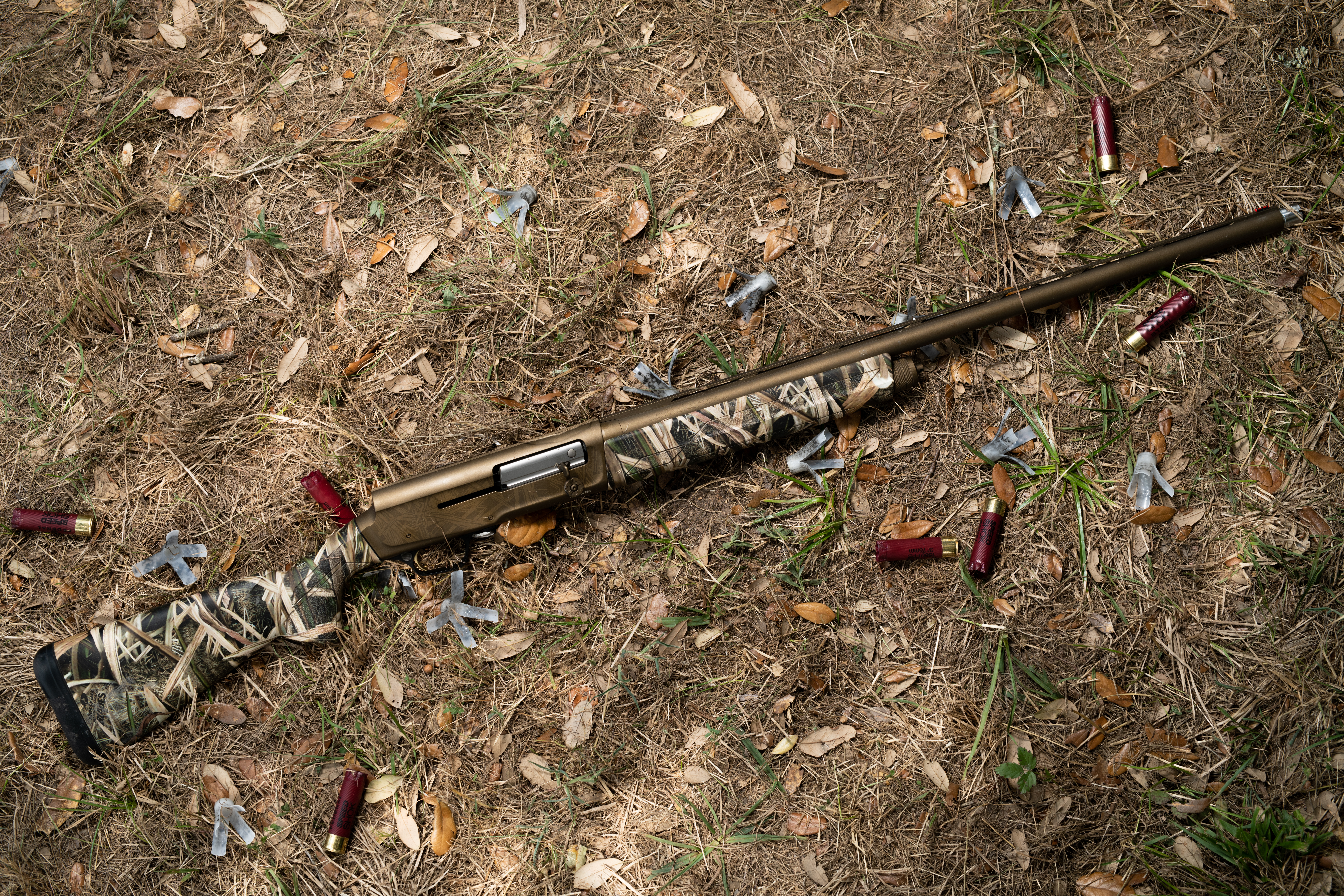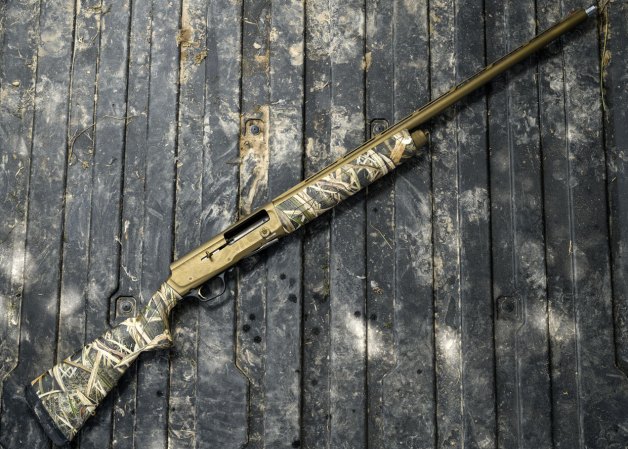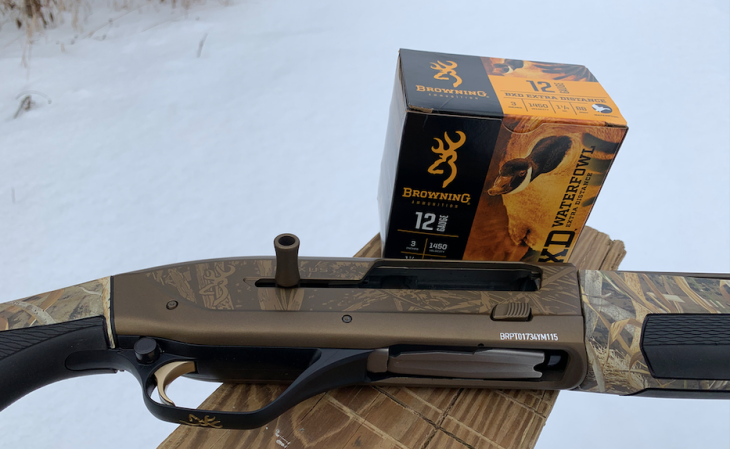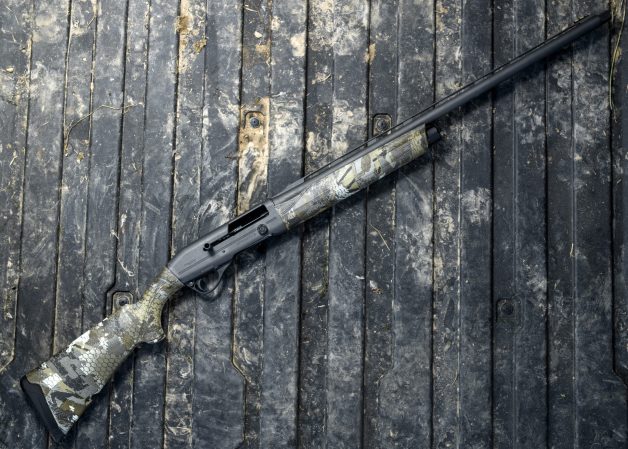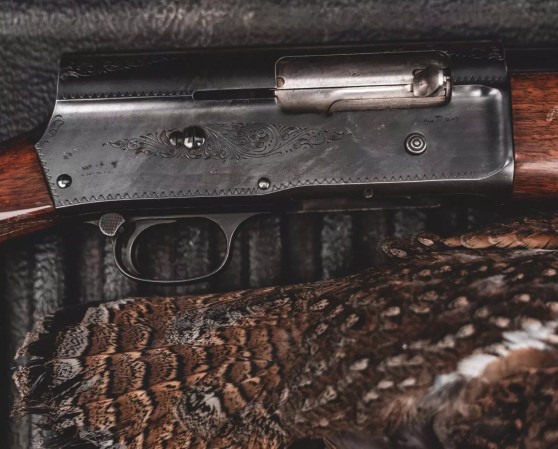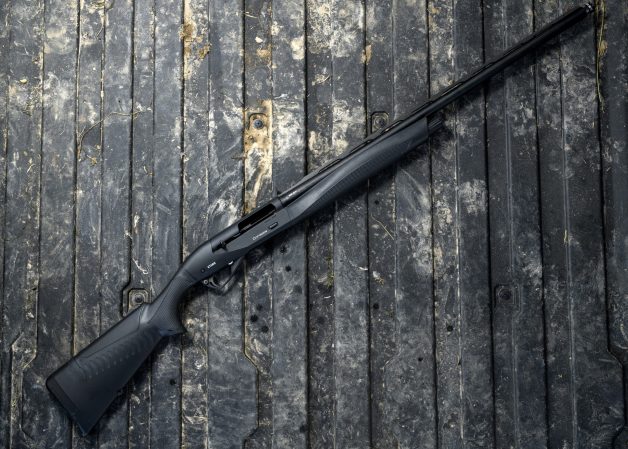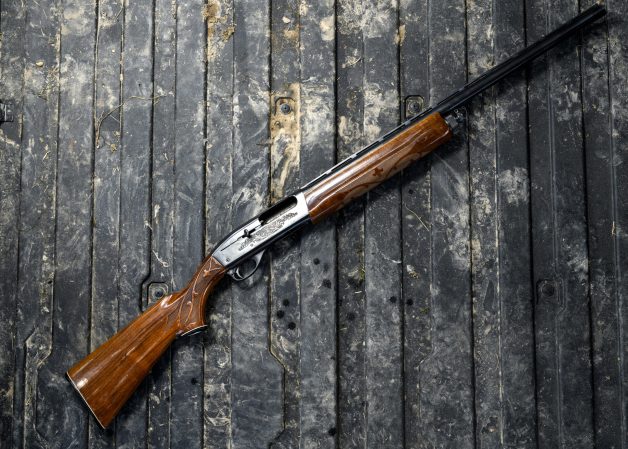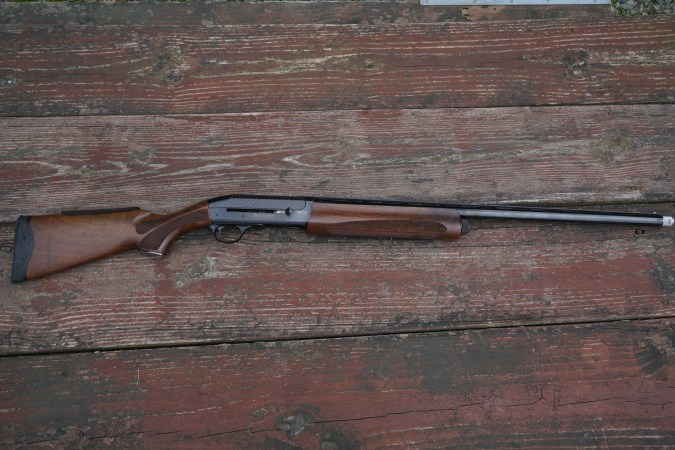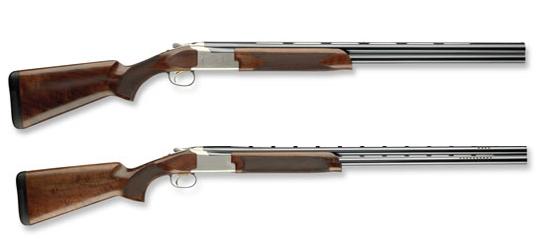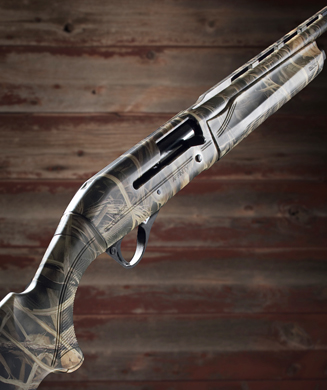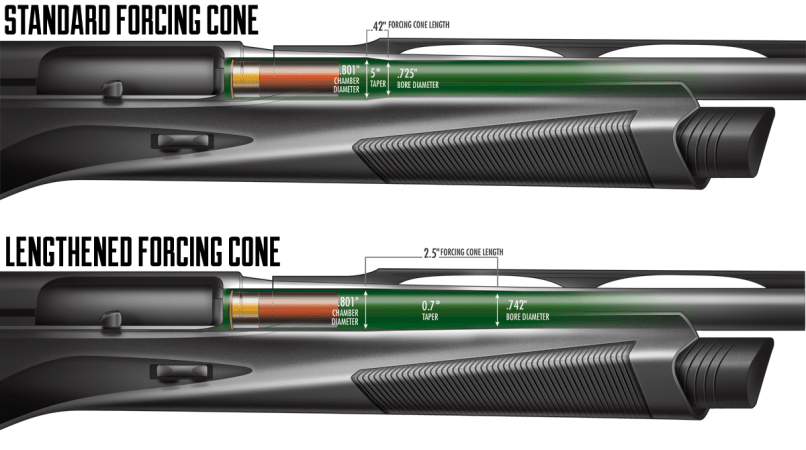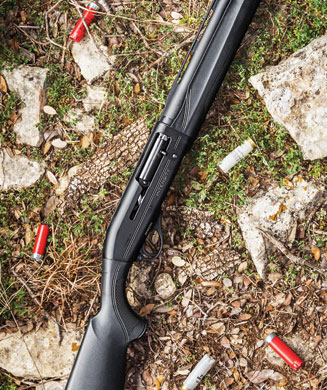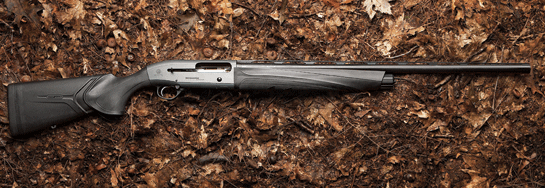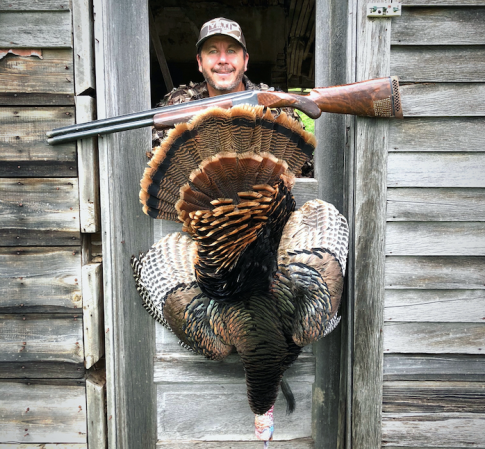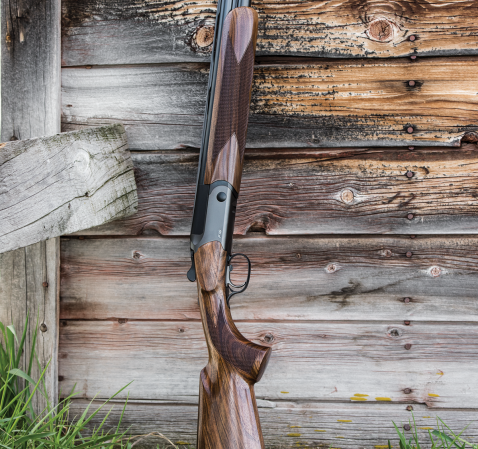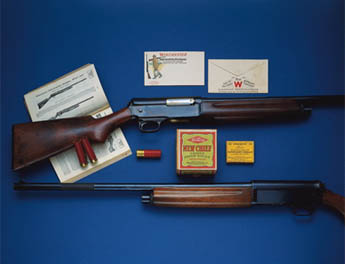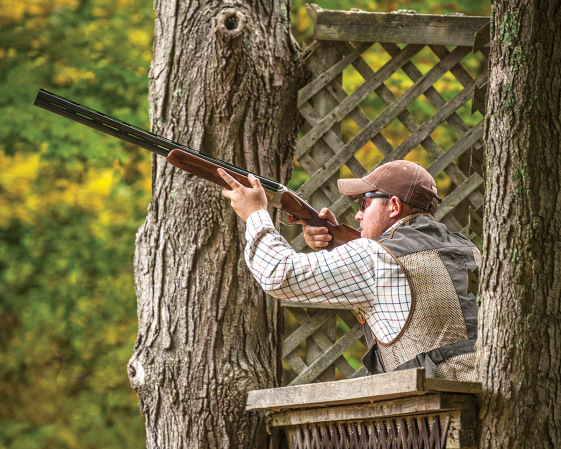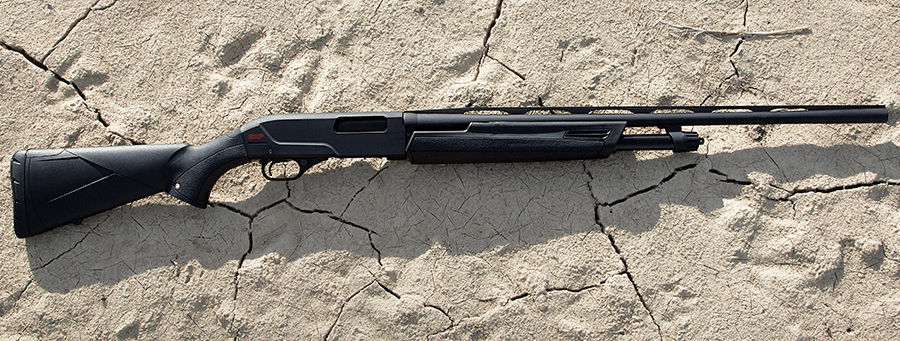We may earn revenue from the products available on this page and participate in affiliate programs. Learn More ›
Of the more than 30 guns John Browning designed, the Auto-5 was one of his most complex to build. In addition to shotguns, Browning developed handguns and rifles, but neither of those firearms are required to cycle the assortment of loads—from light target rounds to heavy duck and turkey ammo—a shotgun must. And at the time, there was no semi-automatic shotgun that could perform such tasks. The long-recoil Auto-5 changed all that. After almost a century in production, Browning (the company) ended its run of the Auto-5 in 1998. During that time (it was patented in 1900), nearly 3 million were sold. In 2012, Browning brought the gun back. Today’s version is called the A5. Its inertia-driven operating system is different from John Browning’s original, and much simpler.
The Browning A5 Wicked Wing has the same hump-back profile as the Auto-5. I’ve shot this gun on ducks in Canada, Kansas, and Texas, where a group of editors from Field and Stream and Outdoor Life tested 17 of the best duck hunting shotguns in Sept. 2021. The A5 has always functioned for me, and it was one of the best patterning guns of our test in terms of pellet distribution inside a 30-inch circle.
The History of the Browning A5
The evolution and places John Browning’s Auto-5 was so vast, books have been written about it. For the sake of brevity, I’ll keep the gun’s history short. Browning built three different versions of the Auto-5 but settled on the long recoil model. The gun was manufactured in Belgium by Fabrique Nationale after Winchester balked at John Browning’s design. Remington was set to make a deal to mass produce the Auto-5, but the president of the company died suddenly of a heart attack before Browning could sign the contract.
The gun was made in Belgium up until World War II when production moved to Remington, because the Nazis took over the FN plant. Production returned in Belgium after the war but moved to Japan in the 1970s before Browning discontinued the Auto-5. Remington also made a version of the Auto-5, called the Model 11, as did Savage, known as the 720. The Auto-5 was offered in 12-, 16-, and 20-gauge. There were 2¾- and 3-inch magnum models in Standard, Light, and Super Lightweight (made with an alloy receiver) options for all kinds of shooters. The Auto-5 was used by hunters, clay shooters, police, and military. Also, it was the only functional semi-automatic shotgun from 1900 to the 1950s when Sears, Roebuck, & Co. debuted the gas-operated Model 60.
After a 13-year production hiatus, Browning brought the gun back in the Browning A5. It looks nearly identical to the Auto-5, but with an inertia-driven operating system, much like that of the Benelli guns. The Auto-5 was also a more well-built gun than the new A5. It was a wood and steel gun that would be much more expensive to make today than the A5, which is built of steel and a synthetic fore-end and stock or steel and Turkish walnut that isn’t the same high-grade wood the old guns were made with.
Browning A5 Wicked Wing Specifications and Features
The A5 is offered in 12-gauge and Sweet Sixteen models. The test gun the four editors from FS and OL—Colin Kearns, Phil Bourjaily, Alex Robinson, and myself—shot was the Browning A5 12-gauge Wicked Wing version, which comes with a bronze Cerakote barrel and receiver, plus Mossy Oak Shadow Grass Habitat on the stock and fore-end. There are also all-camo options in Shadow Grass Habitat and Break-Up Country, along with black synthetic, three walnut and steel options, and the Sweet Sixteen (also walnut and steel).
Here are the standard options included in the Browning A5:
- Gauge: 12 (tested), 16
- Action: Semi-auto
- Capacity: 4+1
- Chamber: 3½- (tested), 3-, 2 ¾-inch (16)
- Barrel type: Chrome-lined
- Barrel length: 26-, 28- (tested), 30-inch
- Choke: Invector DS (IC, M, F)
- Front sight: Fiber-optic
- Length: 49 5/8 inches
- LOP: 14¼ inches
- Trigger pull: 6.9 pounds
- Overall weight: 6.8 pounds
- MSRP: $2,160
How We Tested the Browning A5
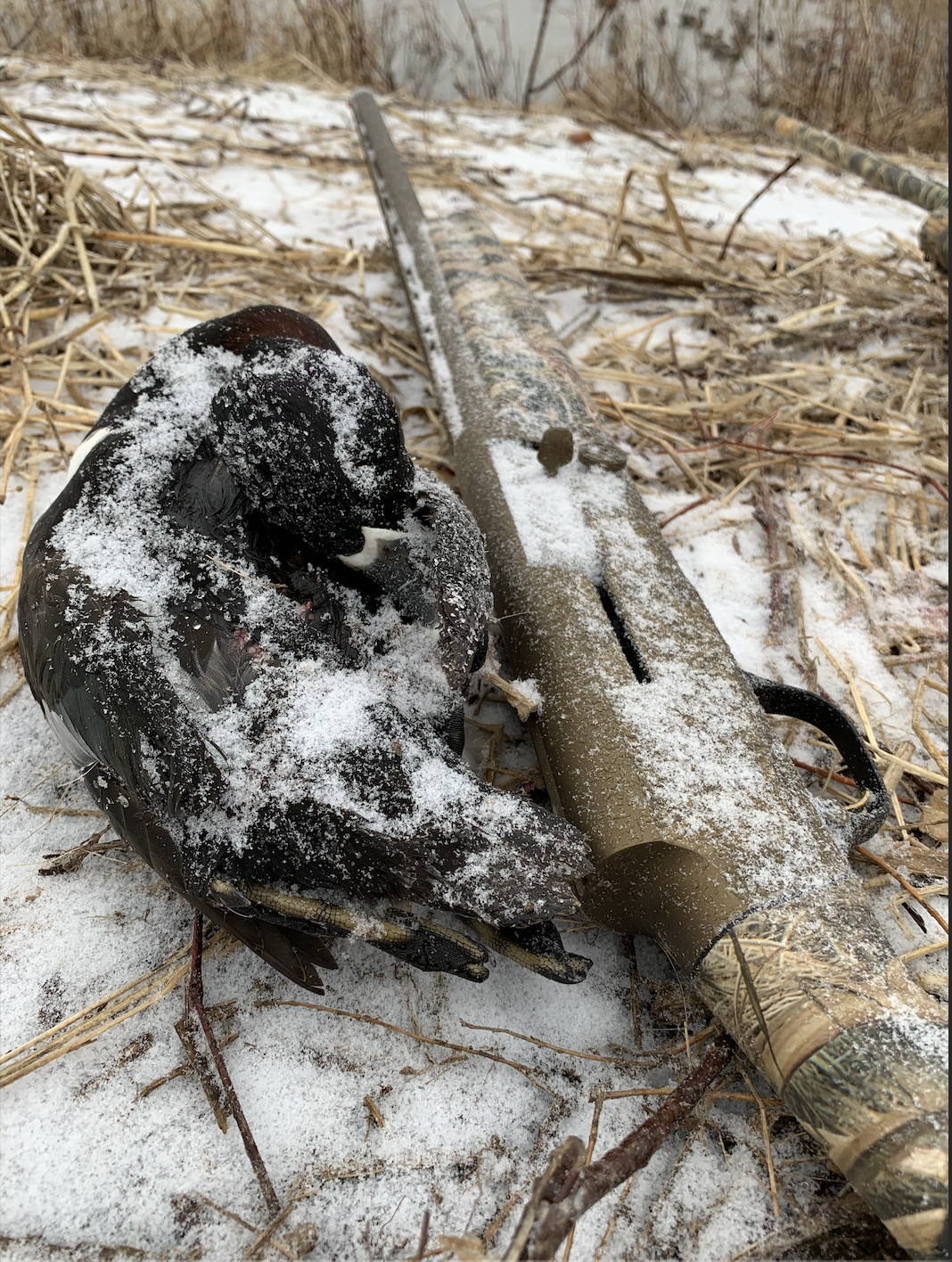
The four editors tested the A5 (and 16 other popular waterfowl hunting shotguns) over three days in September at Pintail Hunting Club in Garwood, Texas. It was early teal season, so we hunted bluewings in the morning and shot five-stand in the afternoons. We also patterned all the guns at 35 yards on a 30-inch circle target. The standard yardage for patterning shotguns is 40 yards, but we wanted to show duck hunters how the gun performed at a distance they would be likely to shoot birds, and 40 yards is at the far end of most hunter’s capabilities with a shotgun.
Each editor also considered five different categories for every shotgun in the test, including how the gun handled and its ergonomics, workmanship and aesthetics, versatility, reliability, and value.
We also tried to make all the guns fail; loading and unloading them at different angles, never cleaning them throughout the course of the test, and not shouldering the guns properly (which can happen in a duck blind) to see how they functioned. The Browning A5 shotgun never failed to cycle a shotshell during the test. I’ve shot the A5 on multiple hunts over the last decade and have experienced similar results. It was reliable for me on a trip to Saskatchewan, where temperatures dipped into the low 30s in the mornings, and in Kansas a few years ago when it was so cold the bolt and receiver frosted over. When the lone duck of the day buzzed the decoys the A5 didn’t fail to fire as I needed three shots to kill a speedy ringneck. Like any inertia gun, the A5 will sometimes fail to cycle if you don’t shoulder it properly. Inertia-driven auto-loaders need a sufficient backstop to function, and if you don’t provide that, they won’t.
The Browning A5 Performed on the Pattern Board
Here is a look at how the Browning A5 patterned from 35 yards inside a 30-inch circle through a modified choke. We patterned each test gun with Federal Speed Shok 3-inch, No. 2s with a muzzle velocity of 1,550 fps and a charge weight of 1 1/8 ounces. The A5’s best pattern placed 116 of a possible 140 pellets (82 percent) inside the target.
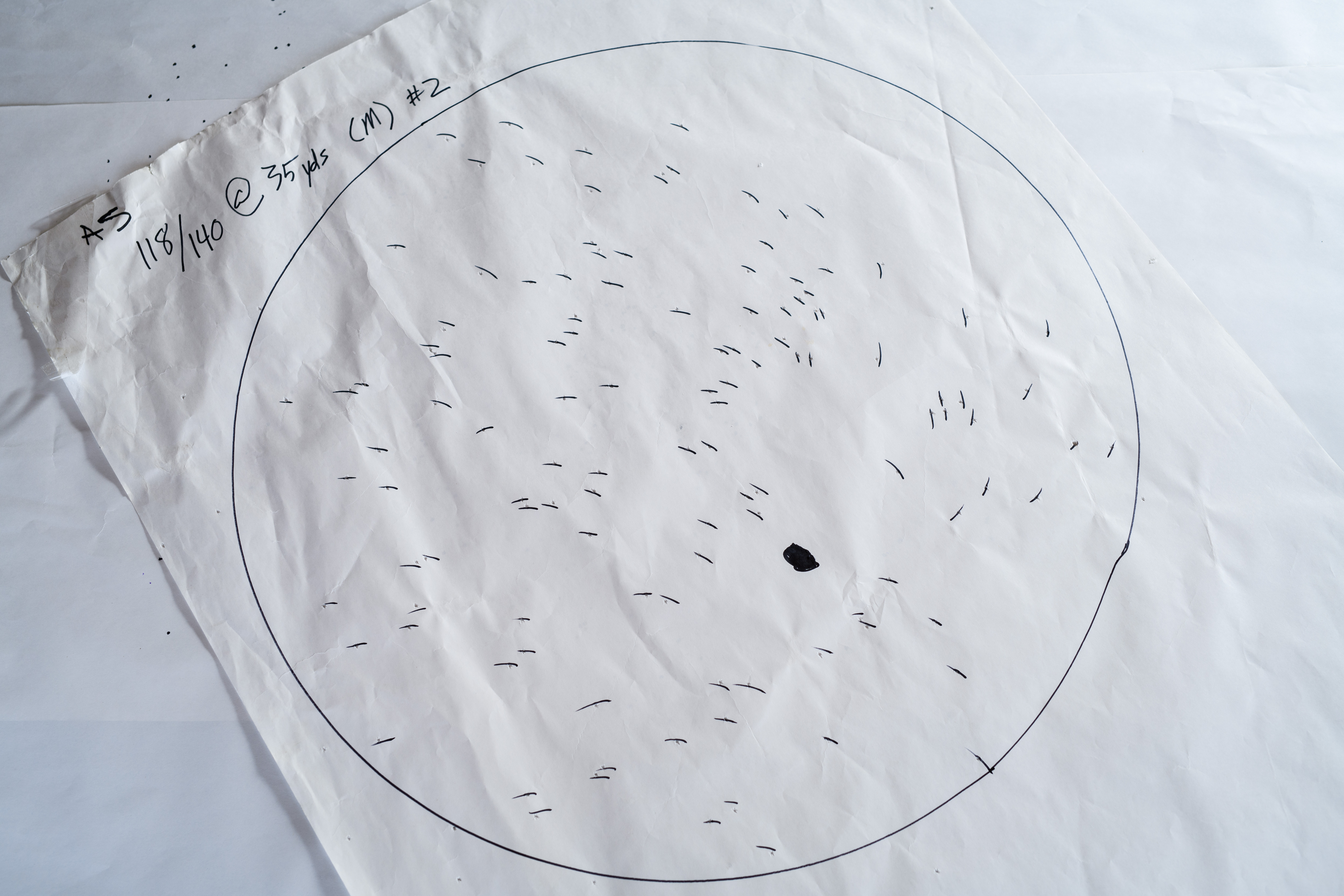
The A5’s pattern percentage fell in the middle of the 17 guns we tested, but the pattern density of the A5 was on the high end of the spectrum. You will notice several pellets are placed in the center of the circle. If you shoot accurately, that means more of your shot will connect with the bird, resulting in clean kills.
How the A5 Handled
The old Browning humpback was beloved by millions because it fit so many different types of shooters, and Browning continued that design with the new A5. The sight plane of the new gun is much the same as the Auto-5, but It handles differently because it’s lighter (6.8 pounds) than most of the first-generation models, which could weigh as much as 9 pounds. The A5 isn’t as svelte as Benelli’s auto-loaders, but it’s plenty trim. That makes the shotgun easy to get moving when you’re surprised by a bluewing teal like all of us were on multiple occasions in Texas.
Browning and Winchester have also started using larger safety buttons on their shotguns, and it makes it much easier to click over and shoot. The safety, which is reversible for lefties, slides over effortlessly, a nice feature when you bring the gun up to shoot. Having a stiff safety (or one you can’t find quickly) can cost you shooting opportunities.
If you have never shot the A5 or other square-backed guns, you may think that hump is obtrusive. It’s not. I’ve found that the A5, and other guns with a squared-off receiver (Benelli, Franchi, Beretta and more have made auto-loaders this way) help my shooting. Rounded actions are slightly harder to get a good sight plane on because you really have to bury your head on the stock. With high-backed guns, there’s more forgiveness, so if you don’t secure the proper mount, you can still make the shot. The Auto-5 had the hump to accommodate the bolt. In the new version, it was kept to give the gun the same look, but most shooters will find it beneficial to their shooting accuracy.
At 6.8 pounds, the A5 is light, even by today’s shotgun standards. Some folks like that in a gun because it’s easy to carry afield and they can also get the gun moving faster when ducks are in the decoys. The knock against lightweight guns is they are harder to keep moving once you get them going, and they also don’t soak up as much recoil. Those two elements can make a shotgun tougher to shoot.
But none of us found that to be the case with the Browning A5 shotgun, except for long crossing shots on clay birds. When you must track a clay with your shotgun for a longer period of time, which is often a requirement for shots at distance, it can be hard to keep the gun moving, particularly if you’re shooting a lighter gun like the A5. But the A5 is also not a sporting clays gun, and most duck hunters have no business shooting birds at 50 yards and beyond unless they are straight overhead. Recoil was a non-factor in the A5, surprising since it’s a sub-7-pound inertia-driven semi-auto. The Inflex Recoil pad made shooting the gun more than tolerable.
The A5 Has Features You Won’t Find in Other Guns
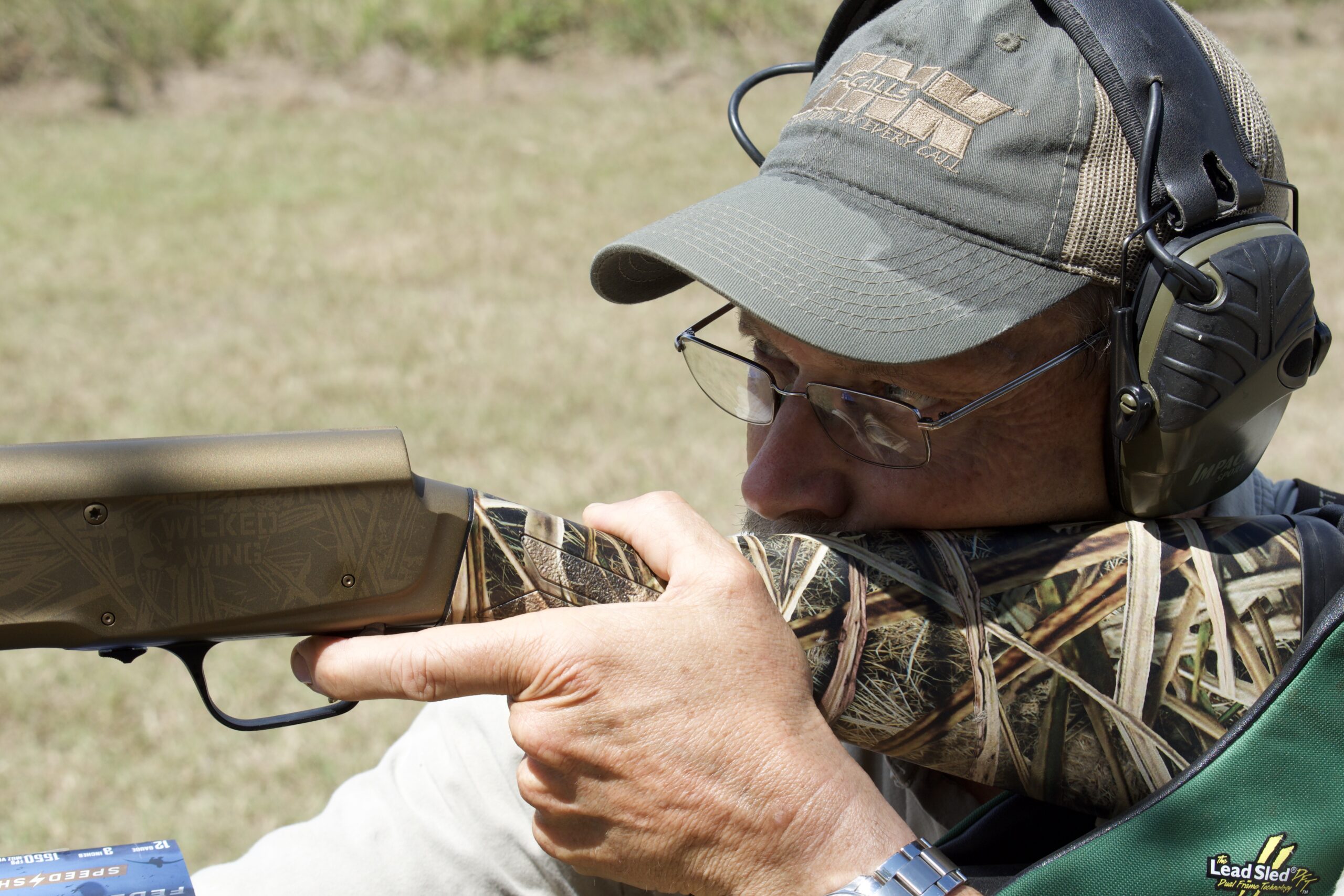
Speed loading was invented by John Browning’s son, Val, and built into the Auto-5. The A5 also has this function. Speed Load Plus allows shooters to load a shotshell into the magazine where it is then sent directly into the chamber. It takes a bit of finger work to get the A5 to speed load. You must push your thumb into the magazine tube as you load the shotshell, and then quickly remove it while avoiding the carrier. If you don’t, the shell just stays in the magazine. It’s a nice feature once you master it, especially if you need to load a shell fast for killing a cripple on the water or sending another shot at a winged bird.
The Speed Load Plus unload feature is convenient too. If you eject the first shotshell from the action, the carrier won’t grab another from the magazine and place it into battery. You can eject the shell, and then unload the remaining two from the mag.
Snow goose hunters will appreciate the Turn-Key magazine cap. It allows you to use any house or car key to remove the plug in the A5. Take off the fore-end and then just stick the key into the hole on top of the magazine cap, push down slightly, and turn. It’s a much less complicated system to deal with than other gun models.
The fit and finish of our test gun was superb. There were no spaces between the receiver and fore-end or where the stock transitioned into the receiver. And the Cerakote finish on the A5 adds durability, which every duck hunter will appreciate.
The only thing that was out of place on the A5 was the bolt-release button, which resembles (and looks like) a plastic poker chip. It’s a feature that is only found on the Browning A5 Wicked Wing model (the rest have a steel button). That’s odd considering the WW gun is the most expensive A5 trim yet Browning chose to put an inexpensive piece of plastic on it. It’s out of place, and doesn’t add anything to the gun, which is otherwise user-friendly.
Browning’s A5 Can Be Used for Multiple Pursuits
Because the A5 is light, it could serve any hunting purpose that requires a shotgun. The original Auto-5 was similarly capable, though versions of the gun would have been a bear to carry all day since some models were so heavy. Pheasants, turkeys, deer, and small game, like rabbits and squirrels are all critters you could pursue with the A5. It would be cumbersome in tight hunting conditions, such as Northwoods grouse or quail in heavy cover, because it’s almost 50 inches long.
The one thing that would make the A5 lineup more versatile is an offering in 20-gauge.
Is the A5 a Good Buy?
The sticking point on this gun is its price. The Wicked Wing model is over $2,000—$1,800 street price. Even the 3-inch black synthetic option carries an MSRP of $1,700. You can buy a Benelli Super Black Eagle 3 or Beretta A400 for around the same cost. Both of those guns were viewed as superior to the A5 by our test group. If you can find an A5 for closer to $1,500, which is possible, it’s worth the money. But $2,000 is high, especially for an inertia gun.
Final Thoughts on the Browning A5
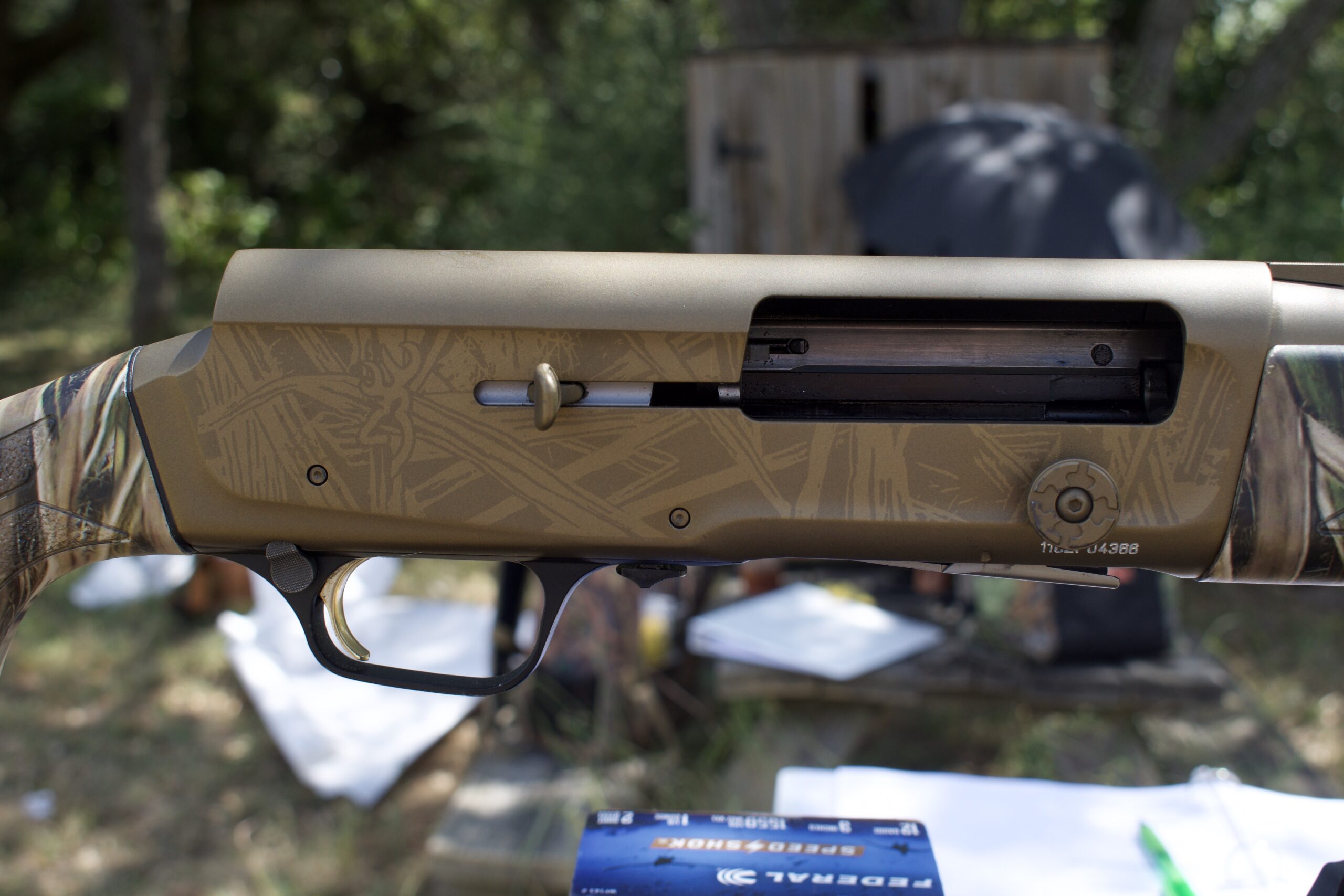
Improving upon a legendary gun such as the Auto-5 is no easy task. And Browning did a fine job with the new A5. They kept everything duck hunters loved about the old gun—its humpback design and reliability—and were able to increase the chamber length to 3½ inches while taking weight out of the gun so it appealed to a wider range of shooters and became more versatile. The only drawback is the gun’s price. It’s hard to fathom how Browning, which makes the Citori—one of the best over/unders for the money—couldn’t make the A5 a little more affordable. But MSRP doesn’t always mirror the shelf price of a shotgun. If you can find a good buy on a Browning A5, there’s no reason not to purchase one.

